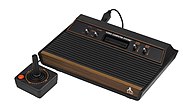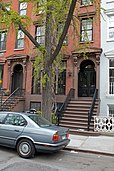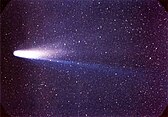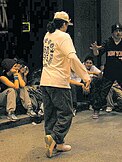Portal:1980s/Selected article
historical reference. . Either the page is no longer relevant or consensus on its purpose has become unclear. To revive discussion, seek broader input via a forum such as the village pump |
| Note: Article entries are now being transcluded directly on the main portal page. However, this page should be retained for historical reference. |
Selected article 1
Portal:1980s/Selected article/1
The Amiga 500, also known as the A500, was the first popular version of the Amiga home computer, "redefining the home computer market and making so-called luxury features such as multitasking and colour a standard long before Microsoft or Apple sold these to the masses". It contains the same Motorola 68000 as the Amiga 1000, as well as the same graphics and sound coprocessors, but is in a smaller case similar to that of the Commodore 128.Commodore announced the Amiga 500 at the January 1987 winter Consumer Electronics Show – at the same time as the high-end Amiga 2000. It was initially available in the Netherlands in April 1987, then the rest of Europe in May. In North America and the UK it was released in October 1987 with a US$699/£499 list price. It competed directly against models in the Atari ST line.
The Amiga 500 was sold in the same retail outlets as the
Selected article 2
Portal:1980s/Selected article/2
TheVolume production started in early 1982, with machines being released on to the market in August at a price of
The C64 dominated the low-end computer market for most of the 1980s. For a substantial period (1983–1986), the C64 had between 30% and 40% share of the US market and two million units sold per year, outselling the
Selected article 3
Portal:1980s/Selected article/3
.Originally called the Magic Cube, the puzzle was licensed by Rubik to be sold by Ideal Toy Corp. in 1980 via businessman Tibor Laczi and Seven Towns founder Tom Kremer, and won the German Game of the Year special award for Best Puzzle that year. As of January 2009, 350 million cubes had been sold worldwide. It is widely considered to be the world's best-selling toy.
In a classic Rubik's Cube, each of the six faces is covered by nine stickers, each of one of six solid colors: white, red, blue, orange, green, and yellow. In currently sold models, white is opposite yellow, blue is opposite green, and orange is opposite red, and the red, white and blue are arranged in that order in a clockwise arrangement. On early cubes, the position of the colours varied from cube to cube. An internal pivot mechanism enables each face to turn independently, thus mixing up the colours. For the puzzle to be solved, each face must be returned to have only one colour. Similar puzzles have now been produced with various numbers of sides, dimensions, and stickers, not all of them by Rubik.
Although the Rubik's Cube reached its height of mainstream popularity in the 1980s, it is still widely known and used. Many speedcubers continue to practice it and other twisty puzzles and compete for the fastest times in various categories. Since 2003, The World Cube Association, the Rubik's Cube's international governing body, has organised competitions worldwide and kept the official world records. (Full article...)
Selected article 4
Portal:1980s/Selected article/4
TheThe
In 2009, the Nintendo Entertainment System was named the single greatest video game console in history by IGN, in a list of 25. (Full article...)
Selected article 5
Portal:1980s/Selected article/5
TheThe crash almost destroyed the then-booming industry and led to the bankruptcy of several companies producing
There were several reasons for the crash, but the main cause was saturation of the market. The full effects of the industry crash would not be felt until 1985. (
Selected article 6
Portal:1980s/Selected article/6
TheThe crew compartment and many other vehicle fragments were eventually recovered from the ocean floor after a lengthy search and recovery operation. The exact timing of the death of the crew is unknown; several crew members are known to have survived the initial breakup of the spacecraft. The shuttle had no escape system, and the impact of the crew compartment with the ocean surface was too violent to be survivable.
The disaster resulted in a 32-month hiatus in the shuttle program and the formation of the Rogers Commission, a special commission appointed by United States President Ronald Reagan to investigate the accident. The Rogers Commission found NASA's organizational culture and decision-making processes had been key contributing factors to the accident, with the agency violating its own safety rules. NASA managers had known since 1977 that contractor Morton Thiokol's design of the SRBs contained a potentially catastrophic flaw in the O-rings, but they had failed to address this problem properly. They also disregarded warnings (an example of "go fever") from engineers about the dangers of launching posed by the low temperatures of that morning, and failed to adequately report these technical concerns to their superiors. (Full article...)
Selected article 7
Portal:1980s/Selected article/7
A
In the United States, the generally accepted times for these and other children's programs to air on Saturday mornings were from 8 a.m. to noon Eastern Time. Until the late 1970s, American networks also had a schedule of children's programming on Sunday mornings, though most programs at this time were repeats of Saturday morning shows that were already out of production. Canadian Saturday morning cartoons were largely defunct by 2002. U.S. broadcast television networks still aired non-E/I animated programs on Saturday mornings until September 27, 2014. Cable television networks have since then revived the practice of debuting their most popular animated programming on Saturday mornings. (Full article...)
Selected article 8
Portal:1980s/Selected article/8
According to the United States government, the crew incorrectly identified the Iranian Airbus A300 as an attacking F-14A Tomcat fighter, a plane made in the United States and operated at that time by only two forces worldwide, the United States Navy and the Islamic Republic of Iran Air Force. While the Iranian F-14s had been supplied by manufacturer Grumman in an air-to-air configuration only in the 1970s, the crew of Vincennes had been briefed when entering the region that the Iranian F-14s carried unguided bombs as well as Maverick missiles and unguided rockets. The Vincennes crew made ten attempts to contact the crew of the flight on military and civilian radio frequencies, but received no response. The International Civil Aviation Organization said that the flight crew should have been monitoring the civilian frequency.
According to the Iranian government, Vincennes negligently shot down the civilian aircraft: the airliner was making IFF squawks in Mode III (not Mode II used by Iranian military planes), a signal that identified it as a civilian craft. The event generated a great deal of criticism of the United States. Some analysts blamed the captain of Vincennes, who had entered Iran's waters, for reckless and aggressive behavior in a tense and dangerous environment.
The United States government did not formally apologize to Iran. In 1996, the United States and Iran reached a settlement at the International Court of Justice. As part of the settlement, the United States did not admit legal liability but agreed to pay on an ex gratia basis US$61.8 million, amounting to $213,103.45 per passenger, in compensation to the families of the Iranian victims. This event ranks eighth among the deadliest disasters in aviation history; the incident retains the highest death toll of any aviation incident in the Persian Gulf. (Full article...)
Selected article 9
Portal:1980s/Selected article/9
The Iran hostage crisis was a diplomatic crisis between Iran and the United States. More than sixty American diplomats and citizens were held hostage for 444 days (November 4, 1979, to January 20, 1981) after a group of Iranian students belonging to the Muslim Student Followers of the Imam's Line, who supported the Iranian Revolution, took over the U.S. Embassy in Tehran.The crisis was described by the Western media as an "entanglement" of "vengeance and mutual incomprehension." President Jimmy Carter called the hostages "victims of terrorism and anarchy" and said, "The United States will not yield to blackmail." In Iran, it was widely seen as a blow against the United States and its influence in Iran, including its perceived attempts to undermine the Iranian Revolution and its longstanding support of the recently overthrown Shah of Iran, Mohammad Reza Pahlavi, who had led an autocratic regime.
After his overthrow in 1979, the shah was admitted to the United States for cancer treatment. Iran demanded that he be returned to stand trial for crimes he was accused of committing during his reign. Specifically, Pahlavi was accused of committing crimes against Iranian citizens with the help of his secret police, the SAVAK. Iranians saw the decision to grant him asylum as American complicity in those atrocities. In the United States, the hostage-taking was seen as an egregious violation of the principles of international law, which granted diplomats immunity from arrest and made diplomatic compounds inviolable.
The crisis reached a climax when, after failed efforts to negotiate the hostages' release, the United States military attempted a rescue operation using ships, including the USS Nimitz and USS Coral Sea, that were patrolling the waters near Iran. On April 24, 1980, the attempt, known as Operation Eagle Claw, failed, resulting in the deaths of eight American servicemen and one Iranian civilian, as well as the destruction of two aircraft. Documents dated two weeks before the operation claim that the American national security advisor, Zbigniew Brzezinski, discussed an invasion of Iran through Turkish bases and territory, though this plan was never executed. (Full article...)
Selected article 10
Portal:1980s/Selected article/10
TheThe Berlin Wall was officially referred to as the "
Before the Wall's erection, 3.5 million East Germans circumvented
Selected article 11
Portal:1980s/Selected article/11
The Valley of the Drums is a 23-acre (9.3 hectare) toxic waste site in northern Bullitt County, Kentucky, near Louisville, named after the waste-containing drums strewn across the area. It is known as one of the primary motivations for the passage of the Comprehensive Environmental Response, Compensation, and Liability Act, or Superfund Act of 1980. While the widely publicized Love Canal disaster is often credited as the reason the Superfund law was passed, Love Canal activist Lois Gibbs has said that Love Canal looked like a suburban community, while "Valley of the Drums became the visualization of the problem."The site became a collection point for toxic wastes starting sometime in the 1960s. It caught the attention of state officials when some of the drums caught fire and burned for more than a week in 1966. However, at that time there were no laws to address the storage or containment of toxic wastes, and the site continued to be unregulated for another decade. In 1977, the owner (also inferred to be the primary "dumper") of the site, A.L. Taylor, died. It is unclear who owns the property today, and county tax records show that the property taxes have gone unpaid for several years.
In 1978, a KDNREP investigation of the property revealed that over 100,000 drums of waste were delivered to the site, of which 27,000 drums were buried and the remaining containers were discharged directly into pits and trenches. Over a period of time, the conditions of many of the drums on site deteriorated and the contents spilled onto the ground and were flushed into a nearby creek by storm water runoff. Frequent complaints about strong odors along the creek bed were received from adjacent property owners.
In 1979, large quantities of contaminants were carried into the creek by the spring snow melts, which caused the Environmental Protection Agency (EPA) to respond immediately. The EPA analyzed the property and creek and found high levels of heavy metal, polychlorinated biphenyls, and some 140 other chemical substances. The same year, the
Selected article 12
Portal:1980s/Selected article/12
The 1985 Live Aid concert was conceived as a follow-on to the successful charity single "
Selected article 13
Portal:1980s/Selected article/13
After sustaining four major gunshot wounds, Lennon was pronounced
Photographer
Selected article 14
Portal:1980s/Selected article/14
Heavy metal (or simply metal) is a genre of rock music with roots in blues rock and psychedelic rock, the bands that created heavy metal developed a thick, massive sound, characterized by highly amplified distortion, extended guitar solos, emphatic beats, and overall loudness. Heavy metal lyrics and performance styles are often associated with masculinity, aggression, and machismo.The first heavy metal bands such as
During the 1980s,
Heavy metal is traditionally characterized by loud distorted guitars, emphatic rhythms, dense bass-and-drum sound, and vigorous vocals. Metal subgenres variously emphasize, alter, or omit one or more of these attributes.
Selected article 15
Portal:1980s/Selected article/15
The Parents Music Resource Center (PMRC) was an American committee formed in 1985 with the stated goal of increasing parental control over the access of children to music deemed to be violent, have drug use or be sexual via labeling albums with Parental Advisory stickers. The committee was founded by four women: Tipper Gore, wife of Senator and later Vice President Al Gore; Susan Baker, wife of Treasury Secretary James Baker; Pam Howar, wife of Washington realtor Raymond Howar; and Sally Nevius, wife of former Washington City Council Chairman John Nevius. They were known as the "Washington wives" – a reference to their husbands' connections with government in the Washington, D.C. area. The term was also a play on the title of Ira Levin's book, The Stepford Wives. The Center eventually grew to include 22 participants.As a method of combating this alleged problem, the PMRC suggested a voluntary move by the
Selected article 16
Portal:1980s/Selected article/16
MTV has spawned numerous
As of July 2015, approximately 92,188,000 American households (79.2% of households with television) received MTV. (Full article...)
Selected article 17
Portal:1980s/Selected article/17 "Where's the beef?" is a catchphrase in the United States and Canada. The phrase originated as a slogan for the fast food chain Wendy's. Since then it has become an all-purpose phrase questioning the substance of an idea, event or product.
The phrase first came to public attention in a
First airing on January 10, 1984, the original commercial featured three elderly ladies at the "Home of the Big Bun" examining an exaggeratedly large hamburger bun. The other two ladies poked at it, exchanging bemused comments ("It certainly is a big bun. It's a very big bun. It's a big fluffy bun. It's a very big fluffy—"). As one of the ladies lift the top half of the bun, a comically minuscule
Selected article 18
Portal:1980s/Selected article/18
In the final scene of the 1979–80 season, J.R. Ewing (Larry Hagman) hears a noise outside his office, walks out to the corridor to look, and is shot twice by an unseen assailant. The episode, titled "A House Divided", was broadcast on March 21, 1980 and was written by Loraine Despres and directed by Leonard Katzman. Viewers had to wait all summer to learn whether J.R. would survive, and which of his many enemies was responsible.
Ultimately, the person who pulled the trigger was revealed to be Kristin Shepard (Mary Crosby) in the "Who Done It?" episode which aired on November 21, 1980. Kristin was J.R.'s scheming sister-in-law and mistress, who shot him in a fit of anger. J.R. did not press charges, as Kristin claimed she was pregnant with his child as a result of their affair.
Production for the 1980–81 season began in June 1980, but Hagman—who had begun the show in a secondary role but now was the star—refused to film the show without a raise. He returned to work ten days later with a new contract that paid him $100,000 per episode and royalties from J.R. Ewing merchandise. Viewers had to wait an additional two months to find out the answer to the famous question, however, as a strike by the Writers Guild of America began in July that delayed the production of most new network shows by eight weeks. During the delay, CBS showed early Dallas episodes featuring J.R. Ewing, helping the show's many new fans better understand his character. (Full article...)
Selected article 19
Portal:1980s/Selected article/19
According to the
With Magnum living a luxurious life on the estate and operating as a P.I. on cases that suit him, the only thorn in the side of this near-perfect lifestyle on the estate is
The relationship between Magnum and Higgins was initially cool but as the series progressed, an unspoken respect and fondness of sorts grew between the pair, and as such, many episodes dedicated more screen time to this "odd couple" pairing after the relationship proved popular with fans. A recurrent theme throughout the last two seasons (starting in the episode "Paper War") involves Magnum's sneaking suspicion that Higgins is actually Robin Masters since he opens Robin's mail, calls Robin's Ferrari "his car", etc. This suspicion is never proved or disproved. (Full article...)
Selected article 20
Portal:1980s/Selected article/20
Since the burial was first reported in the press, there have been doubts as to its veracity and scope, leading to a minority considering it an
In 2014, Fuel Industries, Microsoft, and others worked with the New Mexico government to excavate the site to validate the contents of the landfill as part of a documentary called Atari: Game Over. On April 26, 2014, the excavation revealed discarded games and hardware. Only a small fraction, about 1300 games, were recovered during the excavation period, with a portion given for curation and the rest auctioned to raise money for a museum to commemorate the burial.
Selected article 21
Portal:1980s/Selected article/21
TheThe franchise has expanded beyond film and television. Marvel Comics began publishing The Further Adventures of Indiana Jones in 1983, and Dark Horse Comics earned the comic book rights to the character in 1991. Novelizations of the films have been published, as well as many novels with original adventures, including a series of German novels by Wolfgang Hohlbein, twelve novels set before the films published by Bantam Books, and a series set during the character's childhood inspired by the television show. Numerous Indiana Jones video games have been released since 1982.
The first film,
Selected article 22
Portal:1980s/Selected article/22
The Bhopal disaster, also referred to as the Bhopal gas tragedy, was a gas leak incident in India, considered the world's worst industrial disaster.It occurred on the night of 2–3 December 1984 at the
Estimates vary on the death toll. The official immediate death toll was 2,259. The government of Madhya Pradesh confirmed a total of 3,787 deaths related to the gas release. A government affidavit in 2006 stated that the leak caused 558,125 injuries, including 38,478 temporary partial injuries and approximately 3,900 severely and permanently disabling injuries.
The cause of the disaster remains under debate. The Indian government and local activists argue that slack management and deferred maintenance created a situation where routine pipe maintenance caused a backflow of water into a MIC tank triggering the disaster.
The owner of the factory, UCIL, was majority owned by UCC, with Indian Government-controlled banks and the Indian public holding a 49.1 percent stake. In 1989, UCC paid $470m ($907m in 2014 dollars) to settle litigation stemming from the disaster. In 1994, UCC sold its stake in UCIL to Eveready Industries India Limited (EIIL), which subsequently merged with McLeod Russel (India) Ltd. Eveready ended clean-up on the site in 1998, when it terminated its 99-year lease and turned over control of the site to the state government of Madhya Pradesh. Dow Chemical Company purchased UCC in 2001, seventeen years after the disaster. (Full article...)
Selected article 23
Portal:1980s/Selected article/23
Nearly every aspect of SRA was controversial, including its definition, the source of the allegations and proof thereof, testimonials of alleged victims, and court cases involving the allegations and criminal investigations. The panic affected lawyers', therapists', and social workers' handling of allegations of
Selected article 24
Portal:1980s/Selected article/24
TheIn the early 1980s, the majority of
Initially, crack had higher purity than street powder. The word "street" is used as an adjective meaning "not involving an official business location or permanent residence" such as: "sold on the street" or "street people" in reference to people who live part-time along streets. Around 1984, powder cocaine was available on the street at an average of 55 percent purity for $100 per gram (equivalent to $290 in 2023), and crack was sold at average purity levels of 80-plus percent for the same price. In some major cities, such as New York, Philadelphia, Houston, Los Angeles, and Detroit, one dosage unit of crack could be obtained for as little as $2.50 (equivalent to $7.33 in 2023).
Crack first began to be used on a large scale in Los Angeles in 1984. The distribution and use of the drug exploded that same year. By the end of 1986, it was available in 28 states and the
Selected article 25
Portal:1980s/Selected article/25
A yuppie (/ˈjʌpi/; short for "young urban professional" or "young upwardly-mobile professional") is defined by one source as being "a young college-educated adult who has a job that pays a lot of money and who lives and works in or near a large city". This acronym first came into use in the early 1980s.Selected article 26
Portal:1980s/Selected article/26
"The campaign emerged from a substance abuse prevention program supported by the National Institutes of Health, pioneered in the 1970s by University of Houston Social Psychology Professor Richard I. Evans. Evans's social inoculation model included teaching student skills to resist peer pressure and other social influences. The campaign involved University projects done by students across the nation. Jordan Zimmerman, a student at USF, won the campaign. Zimmerman is the founder of Zimmerman Advertising, the 15th largest advertising corporation in the United States. The anti-drug movement was among the resistance skills recommended in response to low peer pressure, and Nancy Reagan's larger campaign proved to be a useful dissemination of this social inoculation strategy.
Nancy Reagan first became involved during a campaign trip in 1980 to Daytop Village, New York. She recalls feeling impressed by a need to educate the youth about drugs and drug abuse. Upon her husband's election to the presidency, she returned to Daytop Village and outlined how she wished to help educate the youth. She stated in 1981 that her best role would be to bring awareness about the dangers of drug abuse: "Understanding what drugs can do to your children, understanding peer pressure and understanding why they turn to drugs is... the first step in solving the problem." (Full article...)
Selected article 27
Portal:1980s/Selected article/27
At about 09:20 on 31 October 1984, Indira Gandhi was on her way to be interviewed by British actor Peter Ustinov, who was filming a documentary for Irish television. She was walking through the garden of the Prime Minister's Residence at No. 1, Safdarjung Road in New Delhi towards the neighbouring 1 Akbar Road office.
As she passed a wicket gate guarded by Satwant Singh and Beant Singh, the two opened fire.
Selected article 28
Portal:1980s/Selected article/28
TheAccording to official reports, the ship was carrying approximately 55 million US gallons (210,000 m3) of oil, of which about 10.1 to 11 million US gallons (240,000 to 260,000 bbl; 38,000 to 42,000 m3) were spilled into the Prince William Sound. A figure of 11 million US gallons (260,000 bbl; 42,000 m3) was a commonly accepted estimate of the spill's volume and has been used by the State of Alaska's Exxon Valdez Oil Spill Trustee Council, the National Oceanic and Atmospheric Administration and environmental groups such as Greenpeace and the Sierra Club. Some groups, such as Defenders of Wildlife, dispute the official estimates, maintaining that the volume of the spill, which was calculated by subtracting the volume of material removed from the vessel's tanks after the spill from the volume of the original cargo, has been underreported. Alternative calculations, based on the assumption that the official reports underestimated how much seawater had been forced into the damaged tanks, placed the total at 25 to 32 million US gallons (600,000 to 760,000 bbl; 95,000 to 121,000 m3). (Full article...)
Selected article 29
Portal:1980s/Selected article/29
Perestroika is sometimes argued to be a cause of the dissolution of the Soviet Union, the revolutions of 1989 in Eastern Europe, and the end of the Cold War.
Perestroika allowed more independent actions from various ministries and introduced some
In May 1985, Gorbachev gave a speech in Leningrad in which he admitted the slowing down of the economic development and inadequate living standards. This was the first time in Soviet history that a Soviet leader had done so.
The program was furthered at the
During the initial period (1985–87) of Mikhail Gorbachev's time in power, he talked about modifying
Selected article 30
Portal:1980s/Selected article/30
In Russian language the word glasnost has several general and specific meanings. Its meaning "publicity" in the sense "the state of being open to public knowledge" has been used in Russian at least since the end of the 18th century. In the Russian Empire of the later 19th century the latter meaning was particularly associated with reforms of the judicial system, ensuring that the press and the public could attend court hearings and that the sentence was also read out in public. It was revived and made popular again in the 1980s by Mikhail Gorbachev as a slogan for increased government transparency.The demand for glasnost was revived in the mid-1960s on the eve of the
In 1986 the term was revived by
Selected article 31
Portal:1980s/Selected article/31
The Falklands War was a ten-week war between Argentina and the United Kingdom over two British overseas territories in the South Atlantic: the Falkland Islands and South Georgia and the South Sandwich Islands. It began on Friday, 2 April 1982, when Argentina invaded and occupied the Falkland Islands (and, the following day, South Georgia and the South Sandwich Islands) in an attempt to establish the sovereignty it had claimed over them. On 5 April, the British government dispatched a naval task force to engage the Argentine Navy and Air Force before making an amphibious assault on the islands. The conflict lasted 74 days and ended with the Argentine surrender on 14 June 1982, returning the islands to British control. In total, 649 Argentine military personnel, 255 British military personnel, and three Falkland Islanders died during the hostilities.The conflict was a major episode in the
Selected article 32
Portal:1980s/Selected article/32
TheGrenada gained independence from the United Kingdom in 1974. The leftist
The
The invasion was highly criticised by a number of prominent countries including the
Selected article 33
Portal:1980s/Selected article/33
The charges received widespread national attention because of her age (15), the persons accused (including police officers and a prosecuting attorney), and the shocking state in which Brawley was found after the alleged rape (in a trash bag, with racial slurs written on her body and covered in feces). Brawley's accusations were given widespread media attention in part from the involvement of her advisers, including the Reverend
After hearing evidence, a grand jury concluded in October 1988 that Brawley had not been the victim of a forcible sexual assault and that she herself may have created the appearance of such an attack. The New York prosecutor whom Brawley had accused as one of her alleged assailants successfully sued Brawley and her three advisers for defamation.
Brawley initially received considerable support from the African-American community. Some suggested that Brawley was victimized by biased reporting that adhered to racial stereotypes. The mainstream media's coverage drew heated criticism from the African-American press and many black leaders who could brook no degree of skepticism or disbelief of the teenager and her story. The grand jury's conclusions decreased support for Brawley and her advisers. Brawley's family has maintained that the allegations were true. (Full article...)
Selected article 34
Portal:1980s/Selected article/34
TheThe Chernobyl disaster was the worst
The disaster began during a systems test on 26 April 1986 at reactor number four of the Chernobyl plant, which is near the city of
Selected article 35
Portal:1980s/Selected article/35
The incident occurred at a time of severely strained relations between the United States and the Soviet Union. Only three weeks earlier, the Soviet military had shot down a South Korean passenger jet, Korean Air Lines Flight 007, that had strayed into Soviet airspace, killing all 269 people on board.
Bruce Blair, an expert on Cold War nuclear strategies and former president of the World Security Institute in Washington, D.C., says the American–Soviet relationship at that time "had deteriorated to the point where the Soviet Union as a system—not just the Kremlin, not just Soviet leader Yuri Andropov, not just the KGB—but as a system, was geared to expect an attack and to retaliate very quickly to it. It was on hair-trigger alert. It was very nervous and prone to mistakes and accidents. The false alarm that happened on Petrov's watch could not have come at a more dangerous, intense phase in U.S.–Soviet relations." In an interview aired on American television, Blair said, "The Russians [Soviets] saw a U.S. government preparing for a first strike, headed by a President [Ronald Reagan] capable of ordering a first strike." Regarding the incident involving Petrov, he said, "I think that this is the closest our country has come to accidental nuclear war."
On 26 September 1983,
Selected article 36
Portal:1980s/Selected article/36
The Cosby Show is an American television sitcom starring Bill Cosby, which aired for eight seasons on NBC from September 20, 1984 until April 30, 1992. The show focuses on the Huxtable family, an upper middle-class African-American family living in Brooklyn, New York.According to TV Guide, the show "was TV's biggest hit in the 1980s, and almost single-handedly revived the sitcom genre and NBC's ratings fortunes". In May 1992, Entertainment Weekly stated that The Cosby Show helped to make possible a larger variety of shows with a predominantly African-American cast, from In Living Color to The Fresh Prince of Bel-Air.
The Cosby Show was based on comedy routines in Cosby's
The show focuses on the Huxtable family, an
Selected article 37
Portal:1980s/Selected article/37
Solidarity (Polish: Solidarność, pronounced [sɔliˈdarnɔɕt͡ɕ] ⓘ; full name: Independent Self-governing Trade Union "Solidarity" – Niezależny Samorządny Związek Zawodowy „Solidarność” [ɲezaˈlɛʐnɨ samɔˈʐɔndnɨ ˈzvjɔ̃zɛk zavɔˈdɔvɨ sɔliˈdarnɔɕt͡ɕ]) is a Polish trade union that was founded on 17 September 1980 at the Gdańsk Shipyard under the leadership of Lech Wałęsa. It was the first trade union in a Warsaw Pact country that was not controlled by a communist party. Its membership reached 9.5 million members before its September 1981 Congress (when it reached 10 million), which constituted one third of the total working-age population of Poland.In the 1980s, Solidarity was a broad anti-bureaucratic social movement, using the methods of civil resistance to advance the causes of workers' rights and social change. The government attempted to destroy the union by imposing martial law in Poland, which lasted from December 1981 to July 1983 and was followed by several years of political repression, but in the end it was forced to negotiate with Solidarity. In the union's clandestine years, the United States provided significant financial support, estimated to be as much as 50 million US dollars.
The
Selected article 38
Portal:1980s/Selected article/38
A widespread famine affected the inhabitants of today's Eritrea and Ethiopia from 1983 to 1985. The worst famine to hit the country in a century, in northern Ethiopia it led to more than 400,000 deaths, but more than half this mortality can be attributed to human rights abuses that caused the famine to come earlier, strike harder, and extend further than would otherwise have been the case. Other areas of Ethiopia experienced famine for similar reasons, resulting in tens of thousands of additional deaths. The tragedy as a whole took place within the context of more than two decades of insurgency and civil war.The famine of 1983–85 is often ascribed to drought. While climatic causes and consequences certainly played a part in the tragedy, it has been suggested that widespread drought occurred only some months after the famine was under way. The famines that struck Ethiopia between 1961 and 1985, and in particular the one of 1983–5, were in large part created by government policies, specifically the set of counter-insurgency strategies employed and so-called "social transformation" in non-insurgent areas. (Full article...)
Selected article 39
Portal:1980s/Selected article/39
TheThe Iran–Iraq War began when Iraq invaded Iran via air and land on 22 September 1980. It followed a long history of
Despite
Selected article 40
Portal:1980s/Selected article/40
TheThe Macintosh was designed to achieve adequate graphics performance, which had previously required hardware costing over US $100,000, a price inaccessible to the middle class. This narrow goal resulted in an efficient design which traded off expandability but met or exceeded the baseline performance of its competitors. (Full article...)
Selected article 41
Portal:1980s/Selected article/41
The boombox quickly became associated with urban society, particularly
Selected article 42
Portal:1980s/Selected article/42
TheFrom the 1950s
Selected article 43
Portal:1980s/Selected article/43
While often used to refer to rapping, "hip hop" more properly denotes the practice of the
Selected article 44
Portal:1980s/Selected article/44
TheFollowing the
Selected article 45
Portal:1980s/Selected article/45
TheSelected article 46
Portal:1980s/Selected article/46
The prototype was built in 1978 by audio-division engineer
Selected article 47
Portal:1980s/Selected article/47
The Power Glove is a controller accessory for the Nintendo Entertainment System. The Power Glove itself was a commercial success for its early virtual reality mechanics and being shown in various forms of media. However, its two games did not sell well, as it was not packaged with a game, and it was criticized for its imprecise and difficult-to-use controls.The Power Glove was originally released in 1989. Though it was an officially licensed product,
Selected article 48
Portal:1980s/Selected article/48
Halley's Comet or Comet Halley, officially designated 1P/Halley, is a short-period comet visible from Earth every 75–76 years. Halley is the only known short-period comet that is clearly visible to the naked eye from Earth, and the only naked-eye comet that might appear twice in a human lifetime. Halley last appeared in the inner parts of the Solar System in 1986 and will next appear in mid-2061.Halley's returns to the inner Solar System have been observed and recorded by
During its 1986 apparition, Halley's Comet became the first comet to be observed in detail by
Selected article 49
Portal:1980s/Selected article/49
TheLincoln Savings and Loan collapsed in 1989, at a cost of over $3 billion to the federal government. Some 23,000 Lincoln bondholders were defrauded and many investors lost their life savings. The substantial political contributions Keating had made to each of the senators, totaling $1.3 million, attracted considerable public and media attention. After a lengthy investigation, the Senate Ethics Committee determined in 1991 that Cranston, DeConcini, and Riegle had substantially and improperly interfered with the FHLBB's investigation of Lincoln Savings, with Cranston receiving a formal reprimand. Senators Glenn and McCain were cleared of having acted improperly but were criticized for having exercised "poor judgment".
All five senators served out their terms. Only Glenn and McCain ran for re-election, and they both retained their seats. McCain would go on to run for President of the United States twice, and was the Republican Party nominee in 2008. (Full article...)
Selected article 50
Portal:1980s/Selected article/50
The moonwalk (also known as "the Glide" by inner-city youth) is a dance move in which the dancer moves backwards while appearing to be making the physical movement of walking forwards. A popping move, it became popular around the world after Michael Jackson performed the dance move during a performance of "Billie Jean" on Motown 25: Yesterday, Today, Forever on March 25, 1983. This special was broadcast May 16, 1983. It subsequently became his signature move.An illusion is involved in creating the appearance of the dancer gliding backwards. Initially, the front foot is held flat on the ground, while the back foot is in a tiptoe position. The flat front foot remains on the ground but is slid lightly and smoothly backward past the tip-toe back foot. What is now the front foot is lowered flat, while the back foot is raised into the tiptoe position. These steps are repeated over and over creating the illusion that the dancer is being pulled backwards by an unseen force while trying to walk forward. Variations of this move allow the moon walking to also appear to glide forwards, sideways, and even in a circle. (Full article...)















































